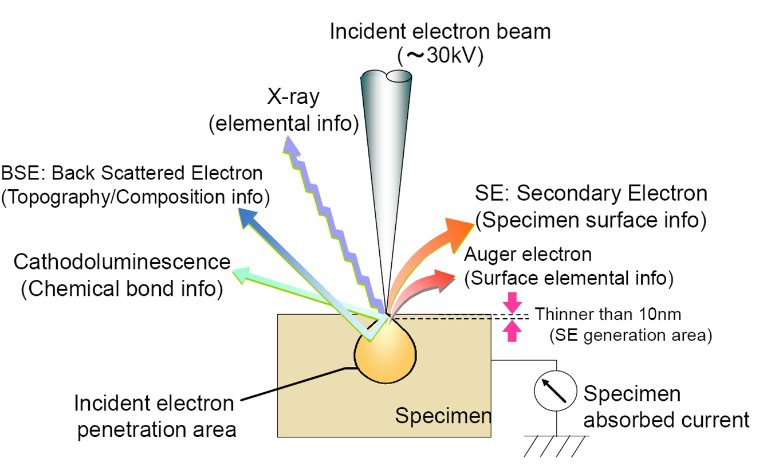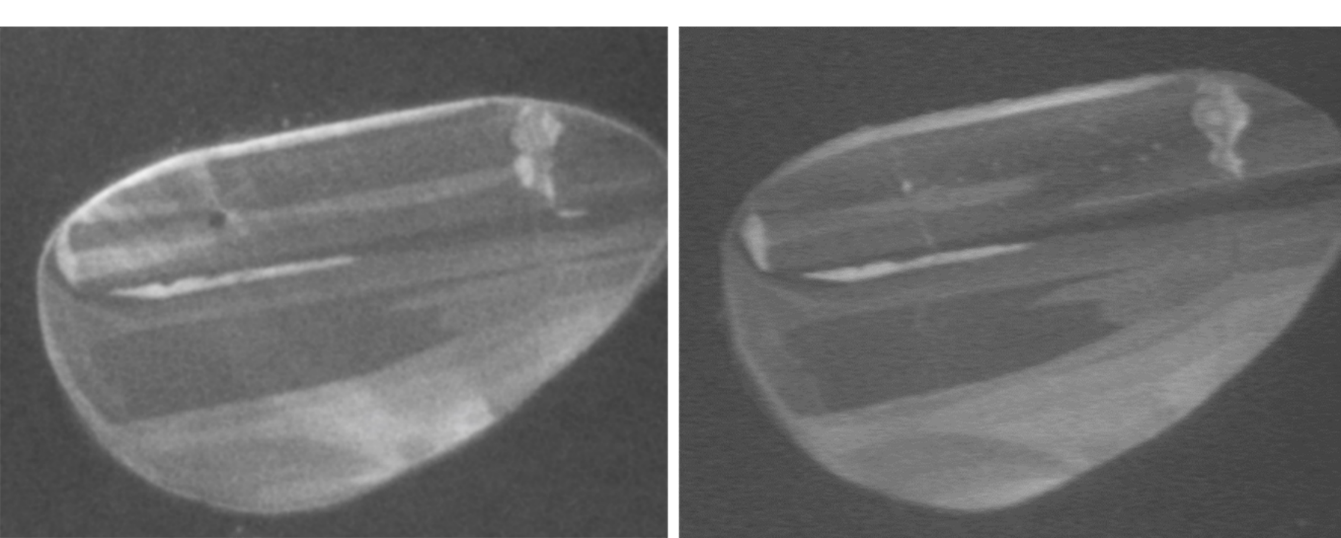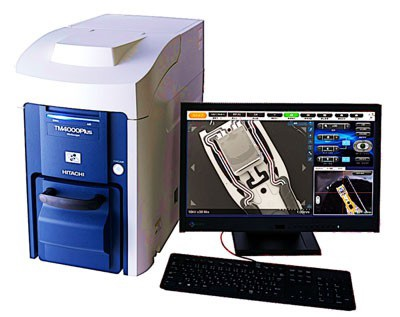Cathodoluminescence (CL) is an approach widely used in electron microscopy for investigations in mineralogy, materials science and semiconductors. It is commonly used in a range of geological studies including dating and studies of defect states in crystals like diamond. It is also used in materials science to deliver critical information on the photonic properties of semiconductors such as solar cells. This article will demonstrate how this type of CL work can be easily and quickly undertaken in the TM4000Plus benchtop SEM from Hitachi.
CL is just one of many processes that can occur when an energetic electron beam impinges on a sample. Typically, for topographical imaging SEM’s use electron signals such as secondary electrons (SE) and backscatter electrons (BSE) for compositional imaging. In addition to these electron signals, a spectrum of electromagnetic radiation is produced, including x-rays which are used for elemental analysis (EDX/EDS). Photons in the infrared, visible, and UV wavelengths may also be emitted in some materials. These photons can then transfer critical information about subtle compositional variations, chemical bonding, band-gap, and crystal structure and defects.

Figure 1. Typical interactions and signals in SEM. Image Credit: Hitachi High-Technologies - Europe
CL imaging is traditionally carried out by adding a dedicated photon detector to an SEM. Simply put, the detector collects photons rather than electrons. The detector may be monochromatic (detecting specific wavelengths as required) or panchromatic (detecting a wide range of wavelengths). The detector may contain a photomultiplier tube and a simple light guide orientated towards the specimen.
To boost the efficiency of collection it may also comprise a parabolic mirror situated immediately above the specimen (which in turn is attached to a photomultiplier tube or a spectrometer if spectral analysis of the photon wavelength is necessary).
However, the Hitachi TM4000Plus facilitates the capability to detect panchromatic CL without any modification. This affords the opportunity to undertake a wide range of rapid panchromatic CL investigations in a simple, cost-effective, readily accessible instrument. CL detection can be achieved with just a single mouse click as the TM4000Plus incorporates a low vacuum secondary electron detector (known as UVD) based on light collection technology.
By switching off the bias which is usually applied to enhance secondary electron detection the detector also operates as a photon detector, with the secondary electron signal suppressed. Moreover, acquiring compositional and CL information simultaneously is achievable as the TM40000Plus also includes dual-channel image handling capability and a high-performance backscatter electron detector – as illustrated in Fig 2 below. The datasets can be even richer if the (optional) EDX elemental mapping capability is activated – offering qualitative and quantitative chemical information in minutes.

Figure 2. Zonation study in coarse-grained syenite with alkali feldspar. From left – CL image showing zonation, BSE image showing composition contrast and Mixed (CL + BSE) image recorded simultaneously
Supporting the geological dating of zircons is another example where the CL method can be promptly applied. Variations in U-Th-Pb ratios within zircon crystals can be used to investigate and establish the date of the crystal’s formation. The small variation in the U-Th-Pb ratio is too small for chemical techniques in the SEM, such as EDX, to detect any real accuracy. The precise ratio of the elements is precisely calculated by mass spectrometry instead. Yet, the challenge is that the mass spectrometer is not able to rapidly identify areas of interest to study.
Therefore, CL in SEM has a vital role when identifying areas of interest for further analysis as it can crucially accelerate the dating process. The apparent “zoning” in CL images of zircons indicates which grains display the largest variations in U-Th-Pb ratios, assisting the geologist to implement mass spectrometry on the most viable crystals.
The example in Fig.3 below compares CL imaging of zircon undertaken in TM4000Plus (left) with the same crystal imaged in a conventional larger SEM with a dedicated CL detector (right). Comparable information is present in both samples and provides the information necessary to decide which grains should be utilized for successive mass spectrometry.

Figure 3. Zircon grains imaged using the Hitachi TM4000Plus (top) and pan-chromatic CL detector in conventional SEM
Conclusion
Conclusively, effective panchromatic imaging capability can be accomplished using a Hitachi benchtop SEM, not only for geological dating but for other zonation studies. Users are provided with an accurate correlation of zoning locations within samples due to the ability to overlay BSE and CL data in one image – either as standalone studies or to facilitate more complex work such as subsequent mass spectrometry.
These instruments provide major solutions to improve the capacity and speed for geological CL imaging as they offer faster time-to-data, require less lab space, require less capital investment, and can be operated easily regardless of previous electron microscope experience. In addition to these benefits, the Hitachi benchtop SEMs presents the opportunity to undertake this type of CL work without any modification or any additional hardware investment. Combined with backscatter electron (BSE) imaging and secondary electron (SE), as well as EDX elemental analysis and mapping, this type of instrument is a dynamic and formidable addition to any Earth Science microscopy facility.
Equipment Used
Hitachi TM4000Plus benchtop SEM in standard configuration.

Acknowledgments
Many thanks to Dr. Eszter Badenszki, University College Dublin, School of Earth Sciences, for providing the Zircons and CL Images for inclusion in this study
Many thanks to Dr. Adam Jeffery, School of Geography, Geology and the Environment, Keele University for the Syenite sample

This information has been sourced, reviewed and adapted from materials provided by Hitachi High-Technologies - Europe.
For more information on this source, please visit Hitachi High-Technologies - Europe.